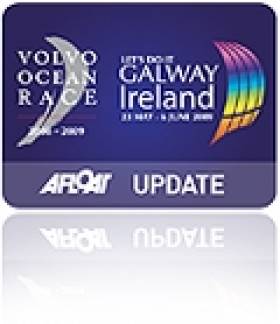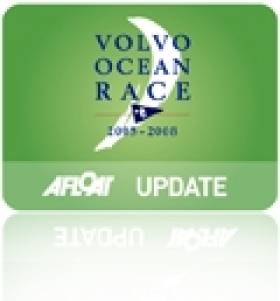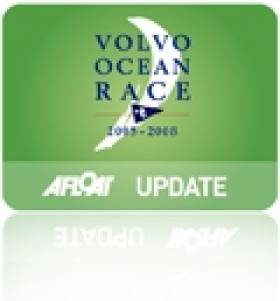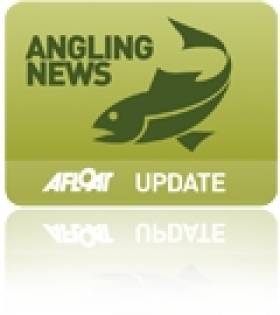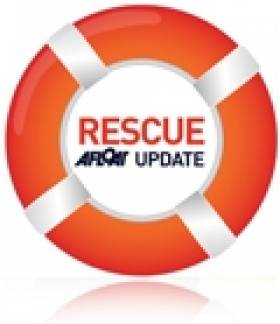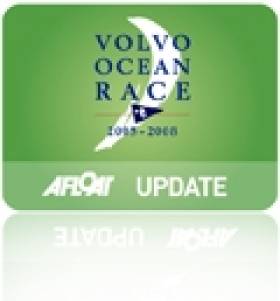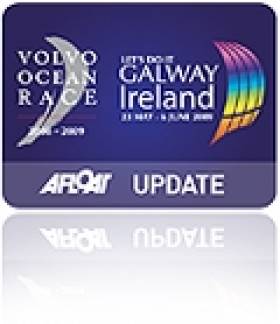Displaying items by tag: Galway
Night of Appreciation for VOR Galway Figurehead John Killeen
#VOLVO OCEAN RACE - An appreciation night was held in Galway last week for John Killeen, who has played a significant role in bringing the Volvo Ocean Race to the city.
As the Galway Independent reports, prominent business leaders and tourism officials were on hand at the Galway Bay Hotel on 17 January to honour the president of Let's Do It Galway - who was also one of three founding members of Ireland's entry in the 2008-2009 race, and was instrumental in bringing that race to the City of the Tribes.
Dan Murphy, president of tourism body Skål International Galway, said it was "only correct and proper" for the travel and tourism industries to recognise Killeen’s contributions to Galway and especially the work he has done bringing the Volvo Ocean Race back to Ireland.
IWDG to Host European Cetacean Conference in Galway This March
#MARINE WILDLIFE - The Irish Whale and Dolphin Group (IWDG) will host the 26th annual European Cetacean Society Conference in Galway on the weekend of 24-25 March this year.
The Galway Bay Hotel will be the site for the main conference sessions, while workshops will also be held at the Galway-Mayo Institute of Technology (GMIT).
This year's gathering is being held under the theme 'Communication: Information and Ideas Worth Sharing'. Participants will be exploring communication between marine mammals as well as between marine scientists, and between scientists and the public.
As Ireland's Wildlife reports, the conference "offers a offers a great opportunity to find out more about whales and dolphins, their conservation, the cetacean research being carried out in Europe and to meet the researchers who are working to uncover the mysteries of these most enigmatic of creatures."
Registration is now open for the two-day event. For full details of the conference programme, venues and booking information, visit the European Cetacean Society Conference micro site HERE.
Showcase for Galway at VOR 'Irish Day' in Adu Dhabi
#VOLVO OCEAN RACE - Galway was showcased on Friday 6 January as part of special a 'Irish Day' celebration in Abu Dhabi, where the Volvo Ocean Race fleet is getting ready to embark on its next leg.
Galway Bay FM reports that the City of the Tribes was highlighted as a top international tourism destination - with the 'VOR Village' at Nimmo's Pier being a focus of discussions, according to Galway Mayor Hildegarde Naughton.
Earlier in the week saw the first sailing in Arab waters of the near-century-old Galway hooker Nora Bheag, which is in Abu Dhabi as part of a cultural exchange between these host ports of the 2011/2012 Volvo Ocean Race.
The race is set to finish in Galway on Tuesday 3 July 2012, attracting the world's media and thousands of visitors to Ireland's fifth largest city for the final prize-giving.
New Helicopter for Irish Coast Guard is Completed
#COASTGUARD - Sikorsky has completed production of a new S-92 helicopter for the Irish Coast Guard under the rescue service's €500 million deal with CHC Ireland.
The US-based helicopter firm and CHC formalised the purchase on Wednesday (21 December) with Irish Coast Guard director Chris Reynolds during a hand-over ceremony at the S-92 commercial helicopter assembly facility in Coatesville, Pennsylvania.
Equipped for dedicated search and rescue (SAR) operations, the helicopter will provide coverage for deep Atlantic Ocean missions, service Ireland's offshore islands and provide rescue cover on the west coast from Cork to Galway.
The new aircraft will be based at Shannon and will replace the current coastguard SAR helicopter, a Sikorsky S-61, which has given 20 years of unbroken service.
According to Sikorsky, the S-92 is equipped with advanced systems and hardware, including an automated flight control system that enables the pilot to fly pre-programmed search patterns and perform delicate hover manoeuvres; a wireless intercom allowing a rescue swimmer to communicate with the crew; radio transceivers to communicate with ships and rescue services; a weather radar and infrared sensor; and a digital video system to record rescues.
Reynolds said the new helicopter - which joins four second-hand machines on a 10-year lease - represents a stepped improvement in Ireland's ability to care for and service its seagoing, coastal and island communities.
"I am very happy that the Coast Guard will operate what I consider to be the leading SAR helicopter in the world," he added.
As reported earlier this year on Afloat.ie, the new chopper is part of a deal that raised questions from a Fine Gael TD over allegations that a competing tender did not have a "good reputation".
Fergus O'Dowd questioning the contract with CHC Ireland after receiving documents in which Chris Reynolds said the Air Corps – whose helicopters are supplied by AgustaWestland - were uneqipped for the role and that no cost saving would be made if they took on the service.
Galway Hooker Sails into Abu Dhabi
#GALWAYHOOKER – Nora Bheag, a near century old Galway Hooker boat, has arrived safely into Abu Dhabi after an historic voyage that set out from the city on Ireland's West Coast by container ship more than six weeks ago.
Nora Bheag ('Little Nora' in English which also means 'Little Light' in Arabic) is in the UAE capital as part of a culture exchange programme to celebrate the maritime histories of Ireland and Abu Dhabi around the emirate's historic hosting of the Volvo Ocean Race, which takes place 31st December 2011 to 14th January 2012. Schoolchildren in Galway have tracked the entire remarkable journey of Little Nora to Abu Dhabi.
The maritime histories of Ireland and the Arabian Gulf have some similarities. Where the Galway Hookers were traditionally used for fishing and transport, Abu Dhabi's dhows shared a similar 'work-boat lineage', associated in their case with pearl-diving, fishing and trade.
The Irish Ambassador to the United Arab Emirates, H.E. Ciarán Madden and members of the Galway Hooker Association, worked together with the Abu Dhabi-based Emirates Heritage Club to develop the cultural exchange programme. With both cities hosting a stopover for the grueling 39,000 mile round the world 'Everest of Sailing' in 2012, the initiative celebrates common ties between the two.
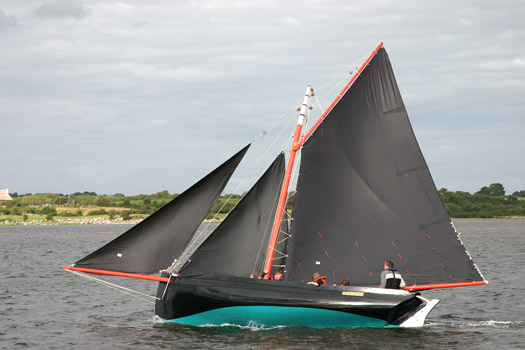
The Legendary Galway ‘Hooker’ has arrived in the UAE Capital for a cultural exchange visit as part of the Volvo Ocean Race
An agreement was made between the Irish Embassy, Emirates Heritage Club, Abu Dhabi Tourism Authority (ADTA) and Tourism Ireland to ship Little Nora to Abu Dhabi for this New Year's Volvo Ocean Race hosting.
Nora Bheag's crew and supporters are expected to arrive in Abu Dhabi on 2nd January when they will launch, rig and prepare her to sail along Abu Dhabi's coast, making her the first Galway Hooker to do so.
Little Nora has a busy schedule lined up during her stay in the UAE capital including being 'guest of honour' at the official Irish Day on the 6th January at the purpose-built Race Destination Village on Abu Dhabi's Corniche breakwater as well as taking members of the public for special trips around the bay.
The return exchange will happen when the Volvo Ocean Race reaches Galway in July next year. An amazing spectacle of six dhows and 60 Emirati crewmembers will be hosted in the city, the Volvo Ocean Race finishing port, to take part in an exhibition race against a fleet of Galway Hookers as part of the grand finale festivities.
About Nora Bheag
Nóra Bheag was built in Galway on the Long Wall overlooking the River Corrib as it joins the sea, by a man called Seán O Dónaill, originally from Lettermullen in Connemara. She was bought by the present owner's (Cóilín Ó hIarnáin's) grandfather Pádraic Ó Maidín in 1938, who lived on Fínis island off Carna in Connemara. She was rigged with a púcán rig (dipping lugsail). She was used to transport animals to and from the mainland, turf from the mainland for fuel, going to Mass on Sundays, bringing goods from the shop and for fishing (dredging scallops in the winter and fishing for lobsters, mackerel, etc. in the summer). Her púcán rig was replaced in 1952 with a gleoiteog rig (gaff cutter rig). Cóilín renovated her extensively (he is a craftsman) in 1988 and has been sailing her in regattas since.
New Archaeological Discoveries in Galway Bay
#GALWAY BAY NEWS - Archaeologists in Galway Bay have unearthed an extensive tidal weir complex at Barna and a late medieval quay on Mutton Island, The Irish Times reports.
The weir, which is estimated to date from the early Christian period, consists of a granite barrier with channels cut through it, designed to control the flow of water in the adjacent lagoon.
Connemara archaeologist Michael Gibbons suggests that the weir implies a considerable fish stock migrating through the area into the Barna river.
The remains of a large Iron Age fort which overlooks the site may also have given its name to the townland of Knocknacarra, which is now a populous suburb of Galway.
Meanwhile, further east at Mutton Island a medieval quay which predates the current lighthouse quay has been found.
The Irish Times has more on the story HERE.
Second Irish Fly Fair Set To Be Bigger and Better
#ANGLING - The Irish Fly Fair and Angling Show at the Galway Bay Hotel next weekend be "the biggest of its kind in Ireland", hosting the largest number of fly tyers and trade stands from over 15 countries, according to organisers.
The two-day exhibition, now in its second year, will welcome some of the world's top fly tyers and angling celebrities to Salthill.
As with the first event last November, visitors will have the opportunity to learn from the world's best fly dressers and casters, with tuition provided by APGAI Ireland.
Returning angling celebs Hywel Morgan, Glenda Powell, Stevie Munn, Paddy McDonnell, Peter O’Reilly will be joined by newcomer Scott MacKenzie to advise on all aspects of fly fishing.
Among the new events this year is the youth fly tying competition, giving younger anglers a chance to show the pros what they can do.
Experts from Inland Fisheries Ireland, the Wild Trout Trust and many more will also be hosting talks and seminar on various angling-related topics.
And all that is aside from the huge trade aspect of the weekend.
"Building on the success of last year’s show, where business was brisk, the 2011 show has attracted trade from all over Europe who are keen to come to Galway and exhibit to the Irish market," said organiser Grace McDermott.
For more details on the second annual Irish Fly Fair and Angling Show visit www.irishflyfair.com.
Man Rescued from Sinking Boat at Galway Docks
The Irish Coast Guard and Galway RNLI lifeboat were alerted and came to his assistance when his eight-foot RIB broke down near Nimmo's Pier around 5pm.
The man was taken safely on board and the RIB was towed to the slipway at the new Ocean Sports Centre. No serious injuries were reported.
Abu Dhabi Team Suffer Broken Mast Six Hours Into VOR
#VOLVO OCEAN RACE - Abu Dhabi Ocean Racing's challenge was nearly scuppered at the outset when their yacht suffered a broken mast just hours into the first leg of the Volvo Ocean Race yesterday. Dismast photos by Paul Todd below.
The accident occurred 30 nautical miles south of Cartagena on the Spanish Mediterranean, when the yacht Azzam encountered rough weather some six hours after leaving Alicante.
"Our mast broke into three pieces when landing off a big wave in 30+ knots of wind," said skipper Ian Walker. "We were sailing under a J4 and two reefs. We do not as yet know the cause."
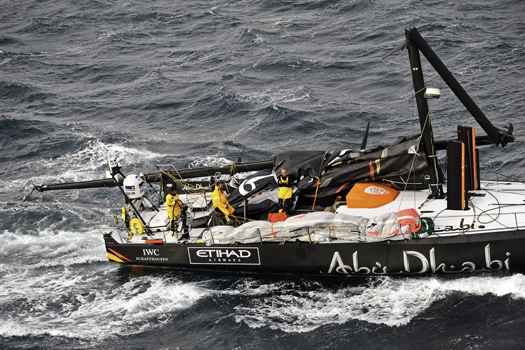
A first leg disaster for Ian Walker on Abu Dhabi - Photo: Paul Todd
The broken mast pieces and rig were recovered, thanks to the "courageous" intervention of crewman Wade Morgan, who entered the water to cut away the top of the mainsail.
Walker added: “The mast from the first spreader up is now secured to the port side of the boat. About three or four metres protrude from behind the boat. A spider web of lines is keeping the operation intact. The crew are deeply disappointed.”
Yacht and crew - which includes Wexford man Justin Slattery - were last night headed towards the flatter water at Cabo de Palos before returning to Alicante under motor to begin repairs and get back in the race.
Abu Dhabi Ocean Racing are one of six teams competing in the epic round-the-world yacht race, which is set to finish in Galway next July.
Earlier this week the team finished first in the initial in-port race of the competition.
The official Volvo Ocean Race website has more on the story HERE.
Galway's 2012 VOR Stopover Will Be 'Bigger and Better'
#VOLVO OCEAN RACE - Organisers for next year's Volvo Ocean Race stopover in Galway have promised the event will be "bigger and better" than the previous race visit in 2009.
John Killeen, president of Let's Do It Galway, told the Galway Independent that he expects as many as 8,000 foreign visitors to the City of the Tribes next July.
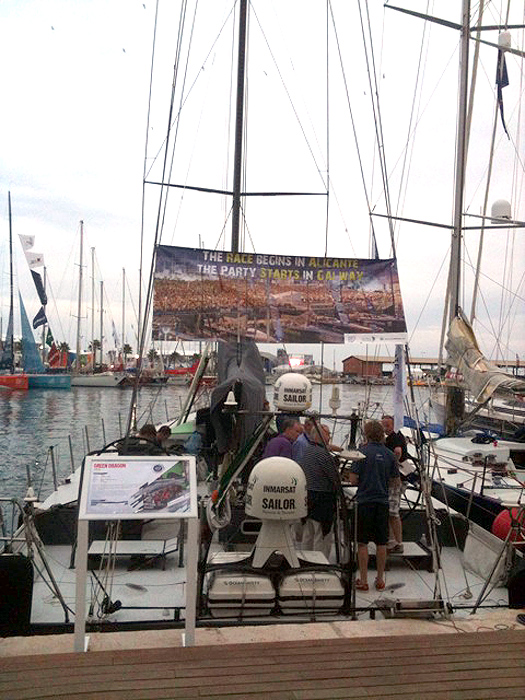
Green Dragon on show in Alicante this week – her dockside poster reads: 'the race begins in Alicante, the party starts in Galway'
Killeen is in Alicante on the Spanish Mediterranean for the week of events and in-port races leading up to the official start of the 2011-12 Volvo Ocean Race this Saturday.
The race is set to finish in Galway on Tuesday 3 July 2012, attracting the world's media to Ireland's fifth largest city for the final prize-giving.
Nimmo's Pier will be the focus of entertainment facilities for the many thousands expected to throng the city as the six competing yachts complete their epic challenge.
"It’s a rare opportunity for Galway and Ireland to have the leverage of such an event and, if we don’t [use it to benefit Galway], it will be remissible,” said Killeen.
The Galway Independent has more on the story HERE.


























